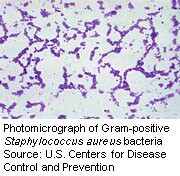
WEDNESDAY, Oct. 30 (HealthDay News) — Researchers who identified a link between staph infections and eczema-like skin rashes say their finding could improve understanding of eczema and help lead to better treatments for the itchy skin condition.
Experiments in mice showed that a toxin produced by Staphylococcus aureus bacteria caused immune system cells in the skin to react in a way that produced eczema-like rashes.
The release of what is called “delta toxin” by staph bacteria caused immune-related cells in the skin to release tiny granules that spur inflammation. This did not occur, however, when skin was exposed to staph strains that did not have the gene for delta toxin, the investigators found.
The study was published Oct. 30 in the journal Nature.
The link between this specific staph toxin and skin rashes suggests a very specific mechanism, but it’s not enough to suggest that delta toxin from staph bacteria by itself causes eczema. It’s likely that genetics also play a role, said study senior author Dr. Gabriel Nunez, a professor of academic pathology at the University of Michigan.
The discovery was made in mice, and it’s too soon to know if the same effect occurs in people with eczema. The researchers did, however, find significant levels of staph delta toxin in skin samples taken from people with eczema.
“We know that 90 percent of patients with atopic dermatitis, also called eczema, have staph bacteria detectable on their skin,” Nunez said in a university news release. “But until now, it has not been suspected that the contribution was primary. … Now we have evidence that there may indeed be a direct link.”
About 15 percent to 30 percent of children and 5 percent of adults have eczema.
More information
The American Academy of Dermatology has more about eczema.
Copyright © 2025 HealthDay. All rights reserved.

